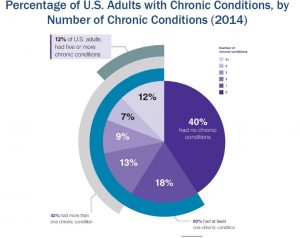
Introduction
Understanding the quantum universe is not an easy thing. Intuitive notions of space and time break down in the tiny realm of subatomic physics, allowing for behavior that seems, to our macro sensibilities, downright weird.
Quantum computers should allow us to harness this strangeness. Such machines could theoretically explore molecular interactions to create new drugs and materials. But perhaps most important, the world itself is built upon this quantum universe — if we want to understand how it works, we probably need quantum tools.
However, current near-term quantum devices are still far from fulfilling that promise, since they can’t reliably execute a large number of quantum interactions. Until researchers can overcome this issue, classical computers remain the best way to solve real-world problems, however inefficiently they do so.
But maybe there’s a workaround, a kind of quantum compromise. A spate of recent papers suggests that it may be possible to take the quantum system you’d like to understand, input its properties into classical machines, and use those machines to predict the quantum system’s behavior. By combining a new way of modeling quantum systems with increasingly sophisticated machine learning algorithms, researchers have established a method for classical machines to model and predict quantum behavior.
“I think the work is very significant,” said Yi-Zhuang You, a physicist at the University of California, San Diego who is unaffiliated with the studies. “It fundamentally changes the field in the sense that it’s the right way to combine quantum computation and machine learning.”
What We Learn From the Shadows
Researchers have been trying to use classical computers to predict quantum states since at least 1989. Typically, a quantum system with n qubits — the quantum equivalent of a bit — can be represented by a classical array of 2n numbers. The size of this array increases exponentially with the number of qubits, meaning that the required computing power quickly becomes prohibitive.
In late 2017, the computer scientist Scott Aaronson suggested that it’s not necessary to know the full classical representation of a quantum system. Instead, you might be able to learn about a given quantum state and predict its properties using only a subset of the representation.
Then in 2020, the physicists Hsin Yuan (Robert) Huang and Richard Kueng pioneered a practical approach to Aaronson’s method. Their technique allowed them to predict many characteristics of the quantum state of a system from very few measurements using classical methods. The process involved constructing a “classical shadow” from these measurements: a succinct classical representation of the quantum system, akin to an actual shadow, which conveys a lot of information — but not everything — about the object casting it.
“You have to lower your sights and only try to predict certain quantum observables,” said John Preskill, a theoretical physicist at the California Institute of Technology who worked with Huang and Kueng on the project.
With this model, if you want to predict a certain number of properties of the system, you need just enough measurements — specifically, a number of measurements that scales as the logarithm of the number of properties. “Robert’s idea is brilliant,” said Xie Chen, a colleague of Preskill’s at Caltech who was not associated with the study. “That is going to give us a big advantage to learn the system by doing some random sampling.”
The approach has already seen some success. Scientists have already used these classical shadows to conduct the largest simulation of quantum chemistry ever undertaken, using a classical algorithm with a noisy, error-prone quantum computer to study the forces experienced by atoms in a diamond crystal.
But perhaps it could do more. Huang and others wanted to study a quantum system not just at one static moment — as in a crystal — but as it changed over time. That would give researchers far more insight into how these systems behave, at the cost of far more data to process. Luckily, by this time another tool had become popular for such a task: machine learning.
Training the Models
In the last few years, classical machine learning models have made revolutionary strides in improving automated predictions. But when researchers tried using them to solve quantum problems, Preskill said, the models often got things right, but their accuracy was not guaranteed. Machine learning typically progresses via trial and error, so you’d need just the right kind of data — and a lot of it — to get useful information.
A paper by Huang and collaborators at Google Quantum AI underscored that intuition: Classical machine learning algorithms trained with enough quantum data can be computationally powerful enough to model quantum systems.
But there was still a problem. These machine learning models were still fundamentally classical, meaning that it’s impossible for them to process truly quantum data and output quantum states. To get around this
SDGs, Targets, and Indicators Analysis
1. Which SDGs are addressed or connected to the issues highlighted in the article?
- SDG 3: Good Health and Well-being
- SDG 4: Quality Education
- SDG 9: Industry, Innovation, and Infrastructure
- SDG 13: Climate Action
- SDG 17: Partnerships for the Goals
The article discusses the use of quantum computers and machine learning algorithms to understand and predict quantum behavior. This has implications for various areas, including healthcare (developing new drugs and materials), education (advancing scientific exploration), innovation and infrastructure (advancing quantum computation and machine learning), climate action (improving understanding of quantum systems’ behavior), and partnerships for achieving these goals.
2. What specific targets under those SDGs can be identified based on the article’s content?
- Target 3.4: By 2030, reduce by one-third premature mortality from non-communicable diseases through prevention and treatment and promote mental health and well-being.
- Target 4.3: By 2030, ensure equal access for all women and men to affordable and quality technical, vocational, and tertiary education, including university.
- Target 9.5: Enhance scientific research, upgrade the technological capabilities of industrial sectors in all countries, in particular developing countries, including, by 2030, encouraging innovation and substantially increasing the number of research and development workers per 1 million people and public and private research and development spending.
- Target 13.3: Improve education, awareness-raising, and human and institutional capacity on climate change mitigation, adaptation, impact reduction, and early warning.
- Target 17.16: Enhance the global partnership for sustainable development, complemented by multi-stakeholder partnerships that mobilize and share knowledge, expertise, technology, and financial resources.
The targets identified are relevant to the issues discussed in the article, such as reducing mortality from non-communicable diseases through improved understanding of quantum behavior, ensuring equal access to quality education in the field of quantum computation and machine learning, enhancing scientific research and technological capabilities, improving education and awareness on climate change, and promoting global partnerships for sustainable development.
3. Are there any indicators mentioned or implied in the article that can be used to measure progress towards the identified targets?
- Indicator 3.4.1: Mortality rate attributed to cardiovascular disease, cancer, diabetes or chronic respiratory disease.
- Indicator 4.3.1: Participation rate of youth and adults in formal and non-formal education and training in the previous 12 months.
- Indicator 9.5.1: Research and development expenditure as a proportion of GDP.
- Indicator 13.3.1: Number of countries that have integrated mitigation, adaptation, impact reduction, and early warning into primary, secondary, and tertiary curricula.
- Indicator 17.16.1: Number of countries reporting progress in multi-stakeholder development effectiveness monitoring frameworks that support the achievement of the sustainable development goals.
These indicators can be used to measure progress towards the identified targets. For example, tracking the mortality rate attributed to non-communicable diseases, participation rates in formal and non-formal education and training, research and development expenditure, integration of climate change education into curricula, and the number of countries reporting progress in multi-stakeholder development effectiveness.
SDGs, Targets, and Indicators Table
| SDGs | Targets | Indicators |
|---|---|---|
| SDG 3: Good Health and Well-being | Target 3.4: By 2030, reduce by one-third premature mortality from non-communicable diseases through prevention and treatment and promote mental health and well-being. | Indicator 3.4.1: Mortality rate attributed to cardiovascular disease, cancer, diabetes or chronic respiratory disease. |
| SDG 4: Quality Education | Target 4.3: By 2030, ensure equal access for all women and men to affordable and quality technical, vocational, and tertiary education, including university. | Indicator 4.3.1: Participation rate of youth and adults in formal and non-formal education and training in the previous 12 months. |
| SDG 9: Industry, Innovation, and Infrastructure | Target 9.5: Enhance scientific research, upgrade the technological capabilities of industrial sectors in all countries, in particular developing countries, including, by 2030, encouraging innovation and substantially increasing the number of research and development workers per 1 million people and public and private research and development spending. | Indicator 9.5.1: Research and development expenditure as a proportion of GDP. |
| SDG 13: Climate Action | Target 13.3: Improve education, awareness-raising, and human and institutional capacity on climate change mitigation, adaptation, impact reduction, and early warning. | Indicator 13.3.1: Number of countries that have integrated mitigation, adaptation, impact reduction, and early warning into primary, secondary, and tertiary curricula. |
| SDG 17: Partnerships for the Goals | Target 17.16: Enhance the global partnership for sustainable development, complemented by multi-stakeholder partnerships that mobilize and share knowledge, expertise, technology, and financial resources. | Indicator 17.16.1: Number of countries reporting progress in multi-stakeholder development effectiveness monitoring frameworks that support the achievement of the sustainable development goals. |
Behold! This splendid article springs forth from the wellspring of knowledge, shaped by a wondrous proprietary AI technology that delved into a vast ocean of data, illuminating the path towards the Sustainable Development Goals. Remember that all rights are reserved by SDG Investors LLC, empowering us to champion progress together.
Source: quantamagazine.org

Join us, as fellow seekers of change, on a transformative journey at https://sdgtalks.ai/welcome, where you can become a member and actively contribute to shaping a brighter future.






